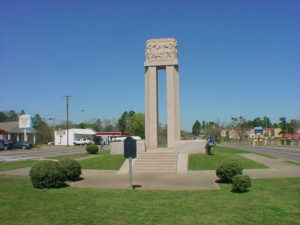If you’ve ever smelled natural gas—it smells like rotten eggs—you can be grateful that a state law exists requiring companies to give it that smell. In such situations, people know that there’s an open gas line or connection that must be closed. Natural gas is flammable.
That law was passed following a tragic explosion that occurred 80 years ago last month in New London, Texas.
New London sits about 124 miles southeast of Dallas, and about 23.5 miles southeast of Tyler. It has a population of approximately 1,000, Thanks to the oil industry, the local school district was among the wealthiest rural school districts in America, even though this was in the midst of the Great Depression.
The New London school building housed students from grades 5-11.
On March 18, 1937, a teacher, Limmie R. Butler, turned on an electric sander. Authorities believed that a spark from the sander ignited a combination of oxygen and natural gas, setting off an explosion. The natural gas came from a faulty leak on a line beneath the school. However, because natural gas is odorless, people didn’t realize there was a problem until it was too late.
The explosion claimed the lives of 294 people, 270 of whom were students.
Tragedies have consequences for all involved. Public outcry was such that the superintendent, W.C. Shaw, was forced to resign his position, despite losing a son in the explosion.
The Texas Legislature passed the odorization law.
The story received its share of news coverage at the time, including from a young United Press reporter, Walter Cronkite, who would go on to be the anchorman of the CBS Evening News.
People around the world sent condolence messages, including Adolf Hitler, who was German chancellor.
The New London explosion has been remembered in a number of ways. Perhaps the most poignant is a memorial cenotaph was built in front of the school site. (The school itself was rebuilt and is known today as West Rusk High School.) Opposite the school sits the London Museum, a museum with artifacts from the explosion.
The explosion is remembered as the third-worst disaster of the 20th century that occurred in Texas. By comparison, the 1900 Great Storm in Galveston claimed between 6,000-8,000 lives. The 1947 Texas City explosion claimed over 600 lives.
All these tragedies have been the subject of multiple books. In the New London case, three books were written and published to coincide with the 75th anniversary of the explosion. These books are:
- David M. Brown and Michael Wereschagin, Gone at 3:17: The Untold Story of the Worst School Disaster in American History (Potomac Books, 2012).
- Bobby Johnson, A Texas Tragedy: The New Little London School Explosion (Stephen F. Austin State University Press, 2012).
- Ron Rozelle, My Boys and Girls Are in There: The 1937 New London School Explosion (Texas A&M University Press, 2012).
The explosion is also the subject of a fascinating website, nlsd.net, which was originally created by William “Bill” Grigg, Jr. who was a son of one of the survivors.

